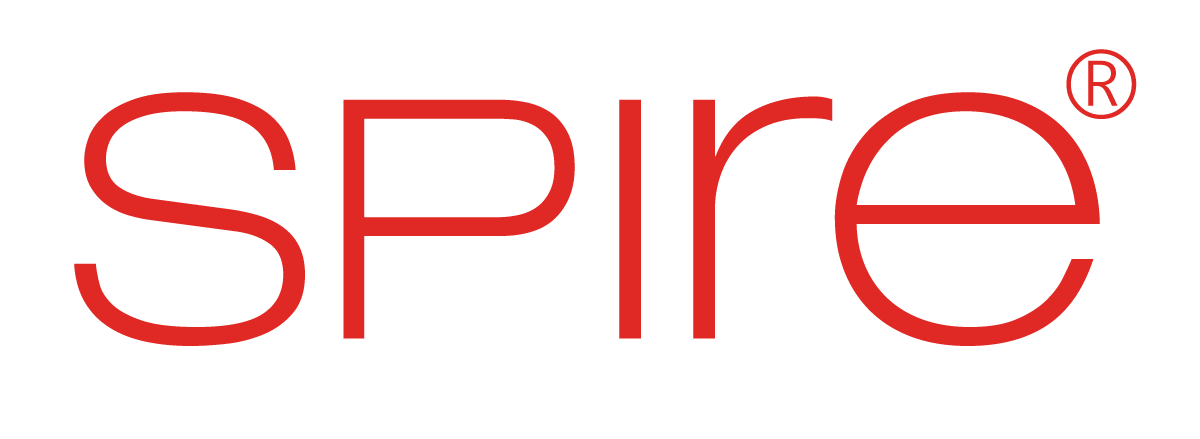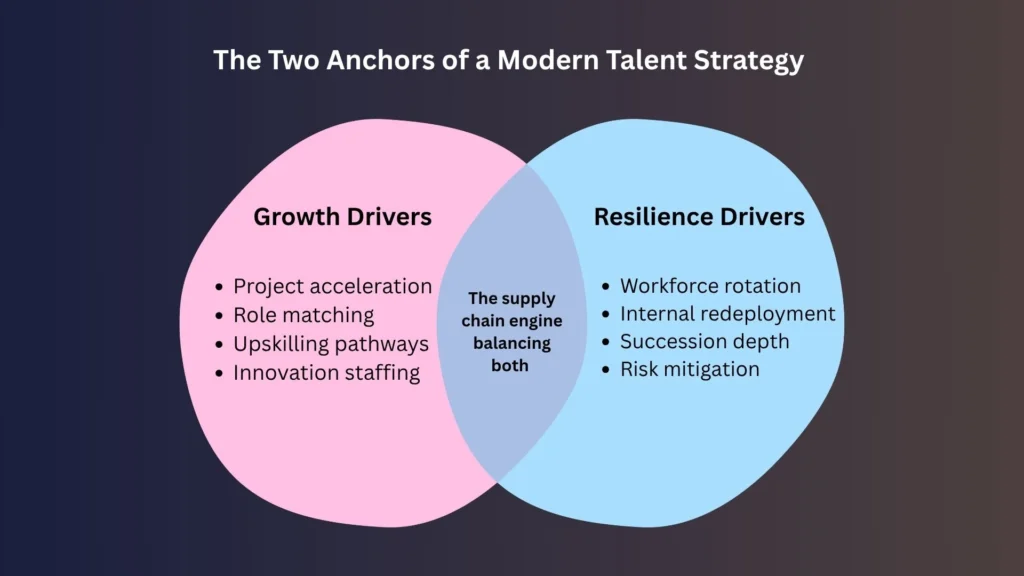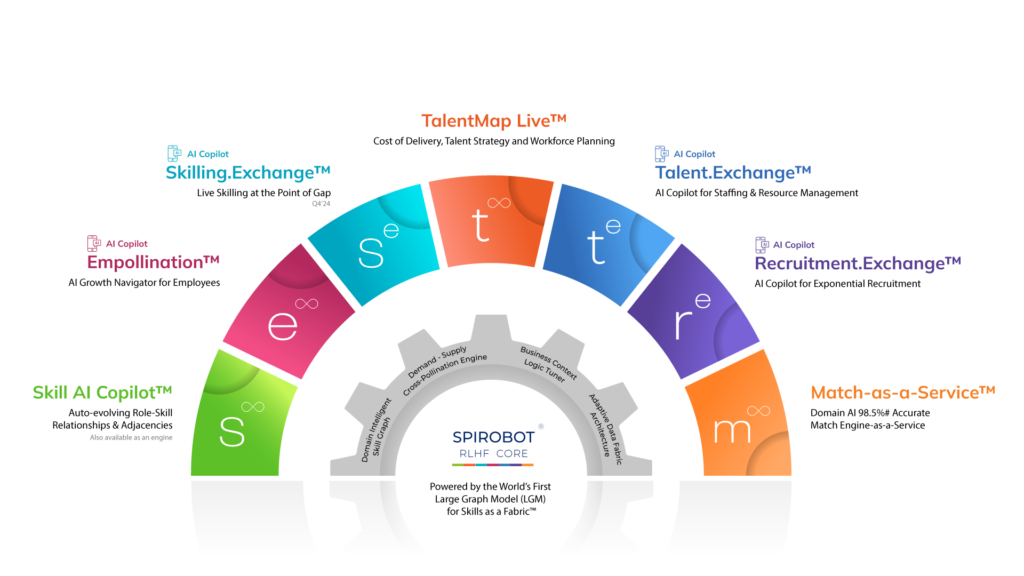The race for growth has long defined how enterprises approach workforce strategy. Expansion into new markets, digital transformation, product innovation, all hinge on the ability to acquire and deploy the right talent, fast. But in a volatile, skills-fragmented, and economically unpredictable world, growth without resilience is risky and unsustainable.
The challenge for today’s enterprise isn’t choosing between growth and resilience. It’s designing a talent model that can deliver both, at scale, and on demand.
That’s where the modern talent supply chain comes in: a new operating framework powered by skill intelligence, workforce agility, and predictive orchestration. In this blog, we explore:
- Why the traditional hiring model is faltering,
- What a resilient talent supply chain looks like in 2025–26,
- And how enterprises can start rearchitecting their workforce today.
Why Traditional Talent Operations Are Breaking
Legacy talent operations were designed for an era of relative stability when business models changed slowly, job roles were well-defined, and the workforce stayed with an employer for years, sometimes decades. But those conditions no longer exist.
Today’s talent environment is shaped by volatility, acceleration, and disruption. From global economic swings to AI-led role transformation, the demands on workforce systems have shifted dramatically. Yet most talent operations remain stuck in the past, leading to persistent inefficiencies and missed opportunities.
Here’s where the cracks are most visible:
1. Static Workforce Planning in a Dynamic Business Landscape
Traditional workforce planning follows an annual cycle: forecast headcount, assign budget, define roles, and hire. This approach assumes that business priorities remain stable over 12–18 months. In reality, market demands, project scopes, and customer needs shift quarterly or faster.
As a result, static plans quickly become obsolete. Hiring cycles lag behind demand curves. Critical roles go unfilled, or worse, get filled too late to make a strategic difference.
2. Overdependence on External Hiring
In conventional models, external hiring is the default response to every gap. Need a new capability? Post a job. Launching a new product line? Recruit fresh talent.
This approach is expensive, slow, and often unnecessary. It ignores the latent capacity already present inside the organization. High-potential employees, adjacent skill holders, and reskill-ready workers are overlooked not because they aren’t capable, but because legacy systems don’t surface them in time.
The result: inflated talent acquisition costs, low internal mobility, and disengagement among existing employees who see no clear path to grow.
3. Outdated Role Definitions and Flat Job Architectures
Job descriptions today are often relics of the past. They list outdated skills, miss emerging ones, and fail to reflect how work is actually delivered, in cross-functional teams, agile pods, or hybrid environments.
In an age of skill convergence (e.g., data + domain + design), flat, title-based architectures limit agility. Employees who could transition across roles are boxed in. Talent strategy becomes reactive and inefficient.
4. Siloed Systems and Fragmented Decision-Making
Workforce data is scattered across HRIS platforms, ATS tools, L&D dashboards, and spreadsheets. Planning decisions are made in silos by HR, by Finance, by business units with no unified view of talent supply, capability, or readiness.
This fragmentation leads to:
- Misalignment between business goals and workforce capabilities,
- Missed opportunities for redeployment,
- And inefficient utilization of critical talent.
5. Manual, Subjective Talent Matching
Even in digitally mature organizations, talent decisions like who to staff on a project or who to promote are often made manually, based on manager input or past performance reviews.
This introduces bias, slows down decisions, and overlooks emerging signals (like recent certifications, project outcomes, or adjacent role readiness). It also prevents organizations from moving talent at the speed of business.
What Is a Talent Supply Chain?
A talent supply chain is an operational system that continuously matches dynamic workforce capacity to shifting business demand. It is:
- Live, not static,
- Predictive, not reactive,
- Skills-based, not title-based.
This model borrows principles from physical supply chains:
- Track and forecast talent like inventory,
- Route internal capacity before external sourcing,
- Build in flexibility to absorb disruption.
At its best, a talent supply chain enables organizations to grow confidently while remaining shock-resistant.
Balancing Two Imperatives: Growth and Resilience
Enterprise leaders today are navigating a paradox: how to scale fast in an unpredictable market, while also staying grounded in workforce continuity and operational control. For decades, talent strategy has swung between these two poles, growth as the pursuit of opportunity, resilience as the shield against disruption. But in today’s reality, choosing one at the expense of the other is no longer viable.
The organizations that will lead tomorrow are those that can do both simultaneously.
That means building a workforce model that:
- Expands capacity without adding excessive cost or complexity,
- Shifts talent quickly as priorities evolve,
- And protects institutional knowledge even as roles and skills evolve.
A modern talent supply chain is designed to reconcile these objectives using AI, skill intelligence, and orchestration to create fluidity without sacrificing control.
Growth: Fueling Speed, Innovation, and Competitive Edge
In high-growth environments, whether entering new markets, launching digital products, or expanding service lines, talent must move fast.
But traditional models can’t keep pace. Hiring cycles are too slow. Capability mapping is reactive. And most importantly, organizations often miss the opportunity to mobilize internal talent already capable of stepping into new roles with minimal ramp-up.
A responsive talent supply chain accelerates growth by:
- Enabling faster time-to-deploy through skill-to-demand matching,
- Increasing internal fulfillment rates, reducing reliance on external hires,
- Activating adjacent skill pathways, allowing employees to grow into emerging roles quickly.
For example, a project requiring cloud migration skills might be fulfilled not by hiring externally, but by identifying internal talent with infrastructure expertise and training them on the delta skills, cutting costs, preserving culture, and boosting morale.
Growth, in this model, is no longer gated by hiring velocity, it’s powered by internal adaptability.
Resilience: Embedding Agility and Continuity Across the Workforce
Resilience isn’t just about bouncing back from disruption. It’s about operating without pause, even when markets, technologies, or teams shift unexpectedly.
A resilient workforce model:
- Can flex capacity quickly in response to demand shocks,
- Retains institutional knowledge through talent redeployment,
- And minimizes risk by avoiding over-dependence on narrow skill bands.
The supply chain model supports resilience by:
- Pre-emptively identifying internal successors for business-critical roles,
- Surface-ready deployment pools to cover unplanned attrition or project spikes,
- Detecting skill obsolescence early and recommending point-of-need skilling interventions.
In this system, workforce stability is not the result of hiring freezes or retention incentives. It’s the result of intelligent, real-time mobility and AI-led orchestration that ensures the right people are always in the right roles.
Why It Matters Now More Than Ever
The global talent landscape is experiencing dual forces:
- An acceleration in skills-based transformation (AI, automation, digitization),
- And a decline in predictability, economic, geopolitical, and operational.
Against this backdrop, businesses that rely on outdated hiring processes or static career paths will struggle to compete. The real differentiator will be the ability to reconfigure talent dynamically, to build new capabilities from within, respond to demand shifts instantly, and do so, at scale.
Balancing growth and resilience are no longer a philosophical trade-off. It’s an operational necessity.
Anatomy of the Modern Talent Supply Chain
Building a modern talent supply chain requires more than process automation or dashboard visibility. It demands a complete shift in how organizations source, deploy, mobilize, and develop talent, not in silos, but as an interconnected, intelligent system.
5 Building Blocks of a Talent Supply Chain
1. Live Skill Visibility
2. Demand Forecasting
3. Internal Fulfillment First
4. Proficiency + Adjacency Mapping
5. Cross-Unit Redeployment Infrastructure
Unlike legacy workforce models that operate in disconnected cycles (recruitment, onboarding, L&D, succession planning), the modern supply chain functions as a live, continuously optimized ecosystem. It blends AI-powered orchestration, real-time skill intelligence, and proactive planning to match workforce capacity with business demand in real time.
Below are the five foundational components that define this new model:
1. Live Skill Visibility
What it is:
A continuously updated view of every employee’s skills, proficiencies, and potential captured automatically from actual work such as certifications, projects, etc.
Why it matters:
Traditional systems rely on resumes, self-assessments, or annual reviews all of which are outdated the moment they’re created. The modern supply chain starts with skill truth: validated, contextualized, and up-to-date insight into what your people can do right now.
How it works:
Using systems like Spire.AI’s Zero-Input Skill Profiling, skill data is inferred from project contributions, certifications, learning outcomes, and performance data, creating a living talent map that evolves with each employee’s journey.
2. Demand Forecasting and Skill Gap Anticipation
What it is:
Predictive modeling of future talent needs based on strategic business inputs, project pipelines, growth plans, attrition trends, and industry shifts.
Why it matters:
Most organizations plan talent reactively, hiring only after a gap becomes disruptive. Modern supply chains instead anticipate need, allowing for smoother transitions, fewer emergency hires, and better utilization of internal resources.
How it works:
Advanced platforms integrate business forecasts with workforce intelligence to simulate future scenarios and pinpoint where talent mismatches will occur. This enables build vs. buy decisions before problems escalate.
3. Internal Fulfillment as First Strategy
What it is:
A systematic approach to prioritizing internal candidates for open roles, projects, and skill gaps before seeking external hires.
Why it matters:
High-potential employees are often overlooked simply because they’re invisible in legacy systems. With internal mobility embedded into the supply chain, organizations reduce hiring costs, improve retention, and increase agility.
How it works:
An AI-enabled internal marketplace automatically surfaces skill matches from across departments and geographies, making it easy to redeploy, reskill, or rotate employees into roles where they’re needed most.
4. Skill Proficiency and Adjacency Mapping
What it is:
Granular analysis of not just what skills an employee has, but how well they’ve demonstrated them and what adjacent capabilities they can grow into.
Why it matters:
A software engineer may not be ready for a data architect role today, but with 70% of the required skills already in place, targeted skilling could make them deployable in weeks. This kind of nuanced insight enables talent fluidity and faster capability development.
How it works:
Using graph-based models, organizations can visualize skill clusters, proficiency levels, and adjacent trajectories, creating intelligent development pathways instead of guesswork-driven L&D programs.
5. Cross-Unit Redeployment Infrastructure
What it is:
A structural capability to move talent across business units, functions, and regions at speed and with minimal friction.
Why it matters:
In most organizations, talent is locked within functional silos. If a team is overstaffed and another is under-resourced, there’s no easy system to reallocate people. A robust talent supply chain eliminates these bottlenecks.
How it works:
AI-driven redeployment engines analyze availability, readiness, and role fit across the enterprise to recommend reallocation plans, preventing talent waste while reducing dependency on contractors or urgent hires.
Sector Spotlight: How Different Industries Are Adopting the Model
Professional Services
- Maximize billable utilization through demand-aligned deployment,
- Reduce bench cost with proactive forecasting and rotation,
- Build resilient pyramid structures with cyclical workforce planning.
Manufacturing & Core Industries
- Enable frontline agility by rotating high-potential workers,
- Decrease dependency on external labor through reskilling,
- Stabilize operations via internal fulfillment during market fluctuations.
Digital and Tech Enterprises
- Scale innovation with project-based matching,
- Accelerate onboarding through skill adjacency analysis,
- Retain critical talent by enabling dynamic internal careers.
Reimagining Metrics for Talent Supply Chains
The shift to a supply chain model brings with it a new set of performance metrics:
|
Metric |
Measures |
|
Skill Fill Rate |
How many open skill gaps are fulfilled internally |
|
Mobility Rate |
Frequency of successful internal movements |
|
Bench-to-Billable Ratio |
% of workforce currently deployed on value-generating work |
|
Time to Productive Deployment |
From request to contribution |
|
Fulfillment Probability |
Likelihood of staffing a demand using existing talent |
These metrics reflect not just activity but strategic agility and business alignment.
Powering the Model: How Spire.AI Orchestrates the Talent Supply Chain
While the concept of a talent supply chain is gaining traction, execution remains the barrier. Spire.AI bridges this gap by providing the foundational intelligence and orchestration required to make it real.
Here’s how:
Live, Contextualized Skill Profiles
Spire.AI creates zero-input, AI-validated skill profiles based on project history, outcomes, and contextual signals, not outdated forms or CVs.
The Large Graph Model (LGM) for Skills
Our LGM maps 11M+ skill relationships across 27 industries, enabling precise, real-time understanding of how skills evolve and cluster across roles.
Agent Sigma™: AI Orchestration Layer
This autonomous agent forecasts demand, calculates fulfillment probability, and recommends optimal deployment strategies, instantly.
Talent.Exchange AI Copilot
Whether you’re staffing a project, modeling capacity, or planning a new initiative, the Copilot simulates workforce readiness against business demand to maximize internal fulfillment before triggering external hiring.
Dynamic Mobility Infrastructure
Spire.AI powers internal marketplaces that match employees to roles and projects, surfacing hidden potential and enabling career acceleration while solving real-time capacity challenges.
Together, these systems form the backbone of an enterprise-grade, AI-powered talent supply chain, one built for scale, speed, and resilience.
Final Thoughts: From Framework to Competitive Advantage
The modern workforce must be treated not as a fixed headcount but as a dynamic, evolving supply chain of capabilities. Organizations that adopt this model will:
- Respond to market shifts with agility,
- Grow without overextending,
- And maintain continuity through change.
But more than that they will transform talent into a competitive advantage, not just a cost center.
The future of workforce strategy is not a question of choosing between growth and resilience. With the right model, you can have both, and Spire.AI is here to make it real.







